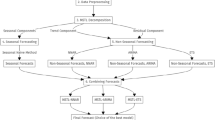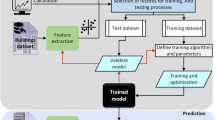Abstract
Accurate forecasting and scientific analysis of building electrical load can improve the level of building energy management to meet the requirements of energy saving. To further strengthen the forecasting accuracy, this study presents a hybrid model for building electrical load forecasting. The proposed method combines the fuzzy inference system and the periodicity knowledge together to generate accurate forecasting results. In this method, in order to better reflect the actual characteristic of the electrical load, the wavelet transform method is firstly utilized to filter the original building electrical load data. Then, the daily periodic pattern is extracted from such filtered electrical load data, and the residual data are obtained through removing the daily periodic pattern. Further, the residual data-driven forecasting model is constructed by the functionally weighted single-input-rule-modules connected fuzzy inference system (FWSIRM-FIS). This FWSIRM-FIS model is used to provide the compensation to the periodic component. In other words, the daily periodic component and the residual forecasting are combined to achieve the final forecasting result. Specifically, in order to assure the forecasting performance of the FWSIRM-FIS model, the subtraction clustering method is employed to construct the SIRMs while the least square estimation is utilized to optimize the parameters in the functional weights of the FWSIRM-FIS. Finally, in this paper, two real-world experiments are made and detailed comparisons with four traditional models are given. Experimental and comparison results demonstrate that the proposed hybrid model has the smallest forecasting errors and can achieve the best performance.














Similar content being viewed by others
References
Tian, C., Li, C., Zhang, G., Lv, Y.: Data driven parallel prediction of building energy consumption using generative adversarial nets. Energy Build. 186, 230–243 (2019)
Li, J.Q., Sang, H.Y., Han, Y.Y., Wang, C.G., Gao, K.Z.: Efficient multi-objective optimization algorithm for hybrid flow shop scheduling problems with setup energy consumptions. J. Clean. Prod. 181, 584–598 (2018)
Crawley, D.B., Lawrie, L.K., Winkelmann, F.C., Buhl, W.F., Huang, Y.J., Pedersen, C.O., Strand, R.K., Liesen, R.J., Fisher, D.E., Witte, M.J., et al.: Energyplus: creating a new-generation building energy simulation program. Energy Build. 33(4), 319–331 (2001)
Norford, L., Socolow, R.H., Hsieh, E.S., Spadaro, G.: Two-to-one discrepancy between measured and predicted performance of a low-energy office building: insights from a reconciliation based on the doe-2 model. Energy Build. 21(2), 121–131 (1994)
Crawley, D.B., Hand, J.W., Kummert, M., Griffith, B.T.: Contrasting the capabilities of building energy performance simulation programs. Build. Environ. 43(4), 661–673 (2008)
Westphal, F.S., Lamberts, R.: The use of simplified weather data to estimate thermal loads of non-residential buildings. Energy Build. 36(8), 847–854 (2004)
Yao, R., Steemers, K.: A method of formulating energy load profile for domestic buildings in the UK. Energy Build. 37(6), 663–671 (2005)
Guo, Y., Nazarian, E., Ko, J., Rajurkar, K.: Hourly cooling load forecasting using time-indexed ARX models with two-stage weighted least squares regression. Energy Convers. Manag. 80, 46–53 (2014)
Kavousi-Fard, A., Kavousi-Fard, F.: A new hybrid correction method for short-term load forecasting based on ARIMA, SVR and CSA. J. Exp. Theor. Artif. Intell. 25(4), 559–574 (2013)
Cui, H., Peng, X.: Summer short-term load forecasting based on ARIMAX model. Power Syst. Protect. Control 43(4), 108–114 (2015)
Newsham, G.R., Donnelly, C.L.: A model of residential energy end-use in Canada: using conditional demand analysis to suggest policy options for community energy planners. Energy Policy 59, 133–142 (2013)
Kouhi, S., Keynia, F.: A new cascade NN based method to short-term load forecast in deregulated electricity market. Energy Convers. Manag. 71, 76–83 (2013)
Zeng, Y.R., Zeng, Y., Choi, B., Wang, L.: Multifactor-influenced energy consumption forecasting using enhanced back-propagation neural network. Energy 127, 381–396 (2017)
Badran, S.M., Abouelatta, O.B.: Forecasting electrical load using ANN combined with multiple regression method. Res. Bull. Jordan ACM 2(2), 152–158 (2011)
Li, K., Hu, C., Liu, G., Xue, W.: Building’s electricity consumption prediction using optimized artificial neural networks and principal component analysis. Energy Build. 108, 106–113 (2015)
Li, T., Guo, J., Luo, D., Tang, J.: Region load forecasting based on load characteristics analysis and GRNN. In: Proceedings of the 9th International Symposium on Linear Drives for Industry Applications, vol. 2, pp. 493–500. Springer, Berlin (2014)
Huo, J., Shi, T., Chang, J.: Comparison of random forest and SVM for electrical short-term load forecast with different data sources. In: 2016 7th IEEE International Conference on Software Engineering and Service Science (ICSESS), pp. 1077–1080. IEEE, New York (2016)
Espinoza, M., Suykens, J.A., De Moor, B.: Fixed-size least squares support vector machines: a large scale application in electrical load forecasting. Comput. Manag. Sci. 3(2), 113–129 (2006)
Chen, Y., Xu, P., Chu, Y., Li, W., Wu, Y., Ni, L., Bao, Y., Wang, K.: Short-term electrical load forecasting using the support vector regression (SVR) model to calculate the demand response baseline for office buildings. Appl. Energy 195, 659–670 (2017)
Duan, P., Xie, K., Guo, T., Huang, X.: Short-term load forecasting for electric power systems using the PSO-SVR and FCM clustering techniques. Energies 4(1), 173–184 (2011)
Lei, Z., Su, W.: Mold level predict of continuous casting using hybrid EMD-SVR-GA algorithm. Processes 7(3), 177 (2019)
Naji, S., Keivani, A., Shamshirband, S., Alengaram, U.J., Jumaat, M.Z., Mansor, Z., Lee, M.: Estimating building energy consumption using extreme learning machine method. Energy 97, 506–516 (2016)
Zhang, Y., Zhang, L., Liu, Y.: Implementation of maximum power point tracking based on variable speed forecasting for wind energy systems. Processes 7(3), 158 (2019)
Li, K., Su, H.: Forecasting building energy consumption with hybrid genetic algorithm-hierarchical adaptive network-based fuzzy inference system. Energy Build. 42(11), 2070–2076 (2010)
Lou, C.W., Dong, M.C.: Modeling data uncertainty on electric load forecasting based on type-2 fuzzy logic set theory. Eng. Appl. Artif. Intell. 25(8), 1567–1576 (2012)
Li, X., Deng, Y., Ding, L., Jiang, L.: Building cooling load forecasting using fuzzy support vector machine and fuzzy c-mean clustering. In: 2010 International Conference on Computer and Communication Technologies in Agriculture Engineering, vol. 1, pp. 438–441. IEEE, New York (2010)
Jain, R., Jain, N., Gupta, Y., Chugh, T., Chugh, T., Hemanth, D.J.: A modified fuzzy logic relation-based approach for electricity consumption forecasting in India. Int. J. Fuzzy Syst. (2019). https://doi.org/10.1007/s40815-019-00704-z
Li, C., Ding, Z., Yi, J., Lv, Y., Zhang, G.: Deep belief network based hybrid model for building energy consumption prediction. Energies 11(1), 242 (2018)
Li, C., Ding, Z., Zhao, D., Yi, J., Zhang, G.: Building energy consumption prediction: an extreme deep learning approach. Energies 10(10), 1525 (2017)
Duan, P.Y., Li, J.Q., Wang, Y., Sang, H.Y., Jia, B.X.: Solving chiller loading optimization problems using an improved teaching-learning-based optimization algorithm. Optim. Control Appl. Methods 39(4), 65–77 (2017)
Li, C., Yi, J., Wang, H., Zhang, G., Li, J.Q.: Interval data driven construction of shadowed sets with application to linguistic word modelling. Inf. Sci. 507, 503–521 (2020)
Pal, S.S., Kar, S.: A hybridized forecasting method based on weight adjustment of neural network using generalized type-2 fuzzy set. Int. J. Fuzzy Syst. 21(1), 308–320 (2019). https://doi.org/10.1007/s40815-018-0534-z
Soto, J., Castillo, O., Melin, P., Pedrycz, W.: A new approach to multiple time series prediction using mimo fuzzy aggregation models with modular neural networks. Int. J. Fuzzy Syst. 21(5), 1629–1648 (2019). https://doi.org/10.1007/s40815-019-00642-w
Yi, J., Yubazaki, N., Hirota, K.: A proposal of SIRMs dynamically connected fuzzy inference model for plural input fuzzy control. Fuzzy Sets Syst. 125(1), 79–92 (2002)
Yi, J., Naoyoshi, Y., Kaoru, H.: Stabilization fuzzy control of parallel-type double inverted pendulum system using the SIRMs dynamically connected fuzzy inference model. Artif. Intell. Eng. 15(3), 297–308 (2001)
Peng, W., Li, C., Zhang, G., Yi, J.: Interval type-2 fuzzy logic based transmission power allocation strategy for lifetime maximization of WSNs. Eng. Appl. Artif. Intell. 87, 103269 (2020). https://doi.org/10.1016/j.engappai.2019.103269
Li, C., Wang, L., Zhang, G., Wang, H., Shang, F.: Functional-type single-input-rule-modules connected neural fuzzy system for wind speed prediction. IEEE/CAA J. Autom. Sin. 4(4), 751–762 (2017)
Seki, H., Nakashima, T.: Some consideration of SIRMs connected fuzzy inference model with functional weights. In: Intelligent Decision Technologies, pp. 471–476. Springer, Berlin (2012)
Li, C., Gao, J., Yi, J., Zhang, G.: Analysis and design of functionally weighted single-input-rule-modules connected fuzzy inference systems. IEEE Trans. Fuzzy Syst. 26(1), 56–71 (2018)
Dordonnat, V., Koopman, S.J., Ooms, M., Dessertaine, A., Collet, J.: An hourly periodic state space model for modelling French national electricity load. Int. J. Forecast. 24(4), 566–587 (2008)
Xue, X., Han, H., Wang, S., Qin, C.: Computational experiment-based evaluation on context-aware O2O service recommendation. IEEE Trans. Serv. Comput. PP(99), 1–1 (2019)
Xue, X., Wang, S., Zhang, L., Feng, Z., Guo, Y.: Social learning evolution (SLE): computational experiment-based modeling framework of social manufacturing. IEEE Trans. Ind. Inform. 15(6), 3343–3355 (2019)
Xue, X., Guo, Y., Chen, S., Wang, S.: Analysis and controlling of manufacturing service ecosystem: a research framework based on the parallel system theory. IEEE Trans. Serv. Comput. 1 (2019). https://doi.org/10.1109/TSC.2019.2917445
Ghaderi, S.F., Azadeh, A., Keyno, H.S.: Forecasting electricity consumption by separating the periodic variable and decompositions the pattern. In: 2007 IEEE International Conference on Industrial Engineering and Engineering Management, pp. 292–296 (2007)
Keyno, H.R.S., Ghaderi, F., Azade, A., Razmi, J.: Forecasting electricity consumption by clustering data in order to decline the periodic variable’s affects and simplification the pattern. Energy Convers. Manag. 50(3), 829–836 (2009)
Zhang, D.: Wavelet transform. In: Fundamentals of Image Data Mining, pp. 35–44. Springer, Berlin (2019)
Chiu, S.L.: Fuzzy model identification based on cluster estimation. J. Intell. Fuzzy Syst. 2(3), 267–278 (1994)
Nelles, O.: Nonlinear System Identification: From Classical Approaches to Neural Networks and Fuzzy Models. Springer Science and Business Media, Berlin (2013)
Golub, G.H., Van Loan, C.F.: Matrix Computations, 4th edn. The Johns Hopkins University Press, Maryland (2013)
Quintana-Orti, G., Quintana-Orti, E.S., Petitet, A.: Efficient solution of the rank-deficient linear least squares problem. SIAM J. Sci. Comput. 20, 1155–1163 (1998)
Zhang, G., Patuwo, B.E., Hu, M.Y.: Forecasting with artificial neural networks: the state of the art. Int. J. Forecast. 14(1), 35–62 (1998)
Güneri Tosunoğlu, N., Apaydın, A.: A new spatial algorithm based on adaptive fuzzy neural network for prediction of crustal motion velocities in earthquake research. Int. J. Fuzzy Syst. 20(5), 1656–1670 (2018). https://doi.org/10.1007/s40815-018-0483-6
Karsoliya, S.: Approximating number of hidden layer neurons in multiple hidden layer BPNN architecture. Int. J. Eng. Trends Technol. 3(6), 714–717 (2012)
Wang, L., Zeng, Y., Chen, T.: Back propagation neural network with adaptive differential evolution algorithm for time series forecasting. Expert Syst. Appl. 42(2), 855–863 (2015)
Shine, P., Scully, T., Upton, J., Murphy, M.D.: Multiple linear regression modelling of on-farm direct water and electricity consumption on pasture based dairy farms. Comput. Electron. Agric. 148, 337–346 (2018)
Funding
This work was financially supported by the Taishan Scholar Project of Shandong Province (TSQN201812092), the Key Research and Development Program of Shandong Province (2019GGX101072), the National Natural Science Foundation of China (61573225, 61473176), and the Youth Innovation Technology Project of Higher School in Shandong Province (2019KJN005).
Author information
Authors and Affiliations
Corresponding author
Ethics declarations
Conflict of interest
The authors have no conflict of interest.
Rights and permissions
About this article
Cite this article
Li, C., Tang, M., Zhang, G. et al. A Hybrid Short-Term Building Electrical Load Forecasting Model Combining the Periodic Pattern, Fuzzy System, and Wavelet Transform. Int. J. Fuzzy Syst. 22, 156–171 (2020). https://doi.org/10.1007/s40815-019-00783-y
Received:
Revised:
Accepted:
Published:
Issue Date:
DOI: https://doi.org/10.1007/s40815-019-00783-y




